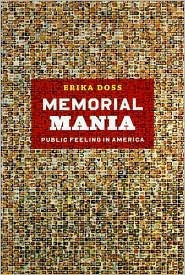 She applied the “Page 99 Test” to her new book, Memorial Mania: Public Feeling in America, and reported the following:
She applied the “Page 99 Test” to her new book, Memorial Mania: Public Feeling in America, and reported the following:From page 99: (and the last line of 98):Learn more about Memorial Mania: Public Feeling in America at the University of Chicago website.Consider the narrative codes of mourning devised by the New York Times in its nationally-syndicated "Portraits of Grief" column, which first appeared three days after 9/11 and continued until late December 2001. Initially called "Among the Missing," the Times' series originated with the missing-persons flyers that circulated immediately after the collapse of the Twin Towers. Featuring personal details and photographs, these Xeroxed flyers were posted on every public surface near Ground Zero, and then, as the missing became the dead, formed the basis for many temporary memorials. Impressionistic and ritualized, much like the memorials on which they were modeled, "Portraits of Grief" were snapshots of affect: two hundred-word profiles, usually accompanied by tiny head-shots, which casually sketched the preferred pastimes (parties, dancing, golf, fly-fishing) and endearing qualities (loved to laugh, loved to cook) of 9/11's victims. Intimate and anecdotal, these sketches were the seeming antithesis to the cold eulogies of the typical newspaper obituary--much as temporary memorials are often cast as the emotional opposites of permanent stone and bronze monuments.Page 99 is toward the end of a chapter in Memorial Mania titled "Grief: Temporary Memorials and Contemporary Modes of Mourning," which focuses on what I see as changed cultural and social practices of public mourning in the United States. As I ask more specifically on page 64: "How are feelings of grief mediated in contemporary America? What do temporary memorials tell us about who and what is deemed memorable in American history, and in terms of an imagined national future? By extension, is grief a useful or productive public affect? Or are there psychic and political dangers for a nation seemingly "too attached" to public expressions of grief?"
Memorial Mania opens with these questions: Why do we make memorials in America today—and why do we make so many of them? I find answers in the fevered pitch of public feeling in America today, including grief, gratitude, fear, shame, and anger. Pairing discussions of particular memorials with the affective conditions in which they are imagined, experienced, and understood, each chapter of Memorial Mania explores the cultural, social, and political conditions that inform today's urgent feelings about history and memory.
Increasing numbers of temporary memorials, for example, like those discussed on p. 99, suggest how new understandings of grief and citizenship are being framed in America today. Memorials that commemorate the victims of terrorism, like the Oklahoma City National Memorial and various 9/11 memorials, simultaneously embody widespread fears about the state of the nation and equally emotional narratives about social stability and national security. Scores of new war memorials, including the National World War II Memorial, negotiate the terms of gratitude and what it means to say "thank you" in America today—and to whom. A growing body of shame-based memorials, including those that address the subjects of slavery and lynching, challenge standard accounts of a progressive national narrative and raise questions about how to remember, represent, and perhaps redeem the nation's shameful histories of racial violence and intolerance. And memorials that pay tribute to Spanish conquistadors in the American southwest are framed by angry debates over revisionist history and foundational myths.
On the whole, page 99 is a good representative of Memorial Mania's primary objective--which looks at today's growing numbers of memorials to show how fresh insights about American history, memory, and self and national identity are especially realized through the lens of public feeling.
--Marshal Zeringue



